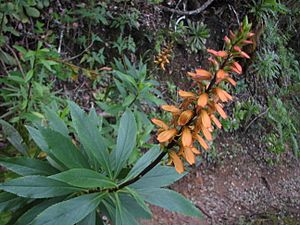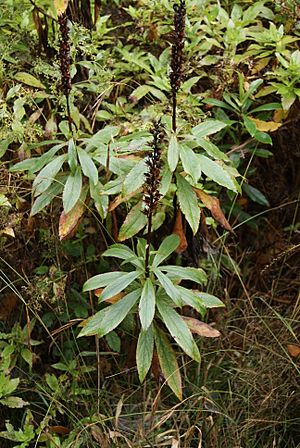Digitalis canariensis facts for kids
Quick facts for kids Digitalis canariensis |
|
|---|---|
 |
|
| Scientific classification | |
| Genus: |
Digitalis
|
| Species: |
canariensis
|
| Synonyms | |
Digitalis canariensis is a beautiful plant that belongs to a group of plants called Digitalis. You might know some other plants from this group, like the common foxglove. This particular plant is special because it only grows in a few places in the world!
Contents
Understanding This Plant
How Scientists Name Plants
The word "taxonomy" is how scientists sort and name living things. Digitalis canariensis is part of the Digitalis genus. A genus is like a family group for plants that are closely related. This plant was once thought to be in its own special group called Isoplexis. That's why you might sometimes see it called Isoplexis canariensis. Scientists are still discussing the best way to classify these plants, but for now, it's mostly known as Digitalis canariensis.
What It Looks Like
Imagine a small, rounded shrub that stays green all year long. That's what Digitalis canariensis looks like! These plants can grow up to 150 centimeters (about 5 feet) tall.
Leaves and Flowers
Its leaves are shaped like a spearhead, a bit wider at the bottom and pointy at the top. They also have small teeth along their edges. The leaves grow in a spiral pattern around the stem.
The plant produces beautiful clusters of orange-reddish flowers. Each flower is about 3 centimeters (just over an inch) big. They have short petals and two noticeable "lips" – one on top and one on the bottom.
Pollination and Fruit
Did you know that birds help these plants make seeds? Small birds, especially a type of warbler called Phylloscopus, visit the flowers. As they drink the nectar, they help move pollen from one flower to another. This process is called bird pollination. After the flowers are pollinated, the plant grows a fruit that looks like a small capsule.
Where It Grows
Digitalis canariensis is a plant that is endemic to the Canary Islands. This means it naturally grows only in this specific place and nowhere else in the world! You can find it on the islands of Tenerife, La Gomera, and La Palma. It likes to grow in wooded areas, especially in laurel forests and woods covered with Erica arborea trees.
See also
 In Spanish: Digitalis canariensis para niños
In Spanish: Digitalis canariensis para niños


